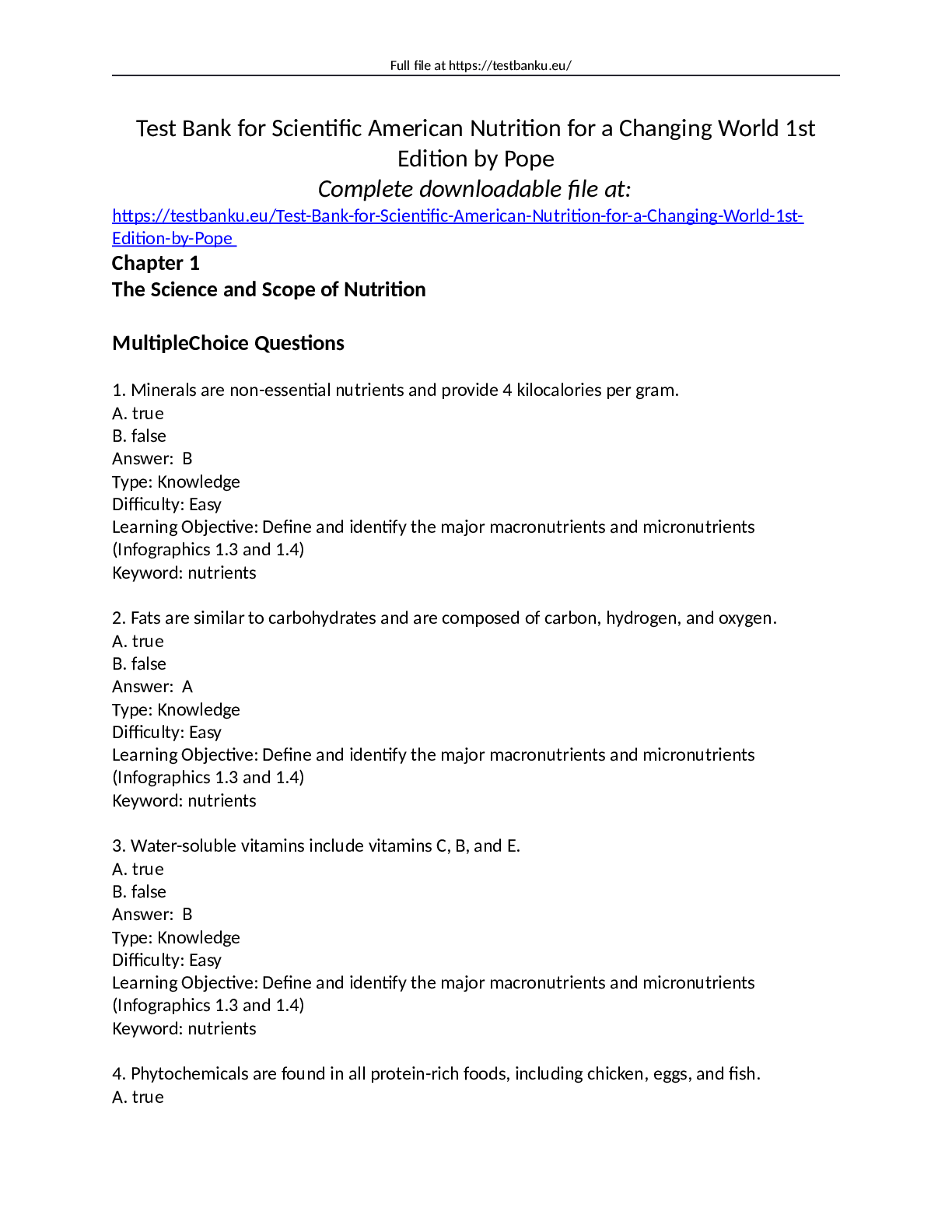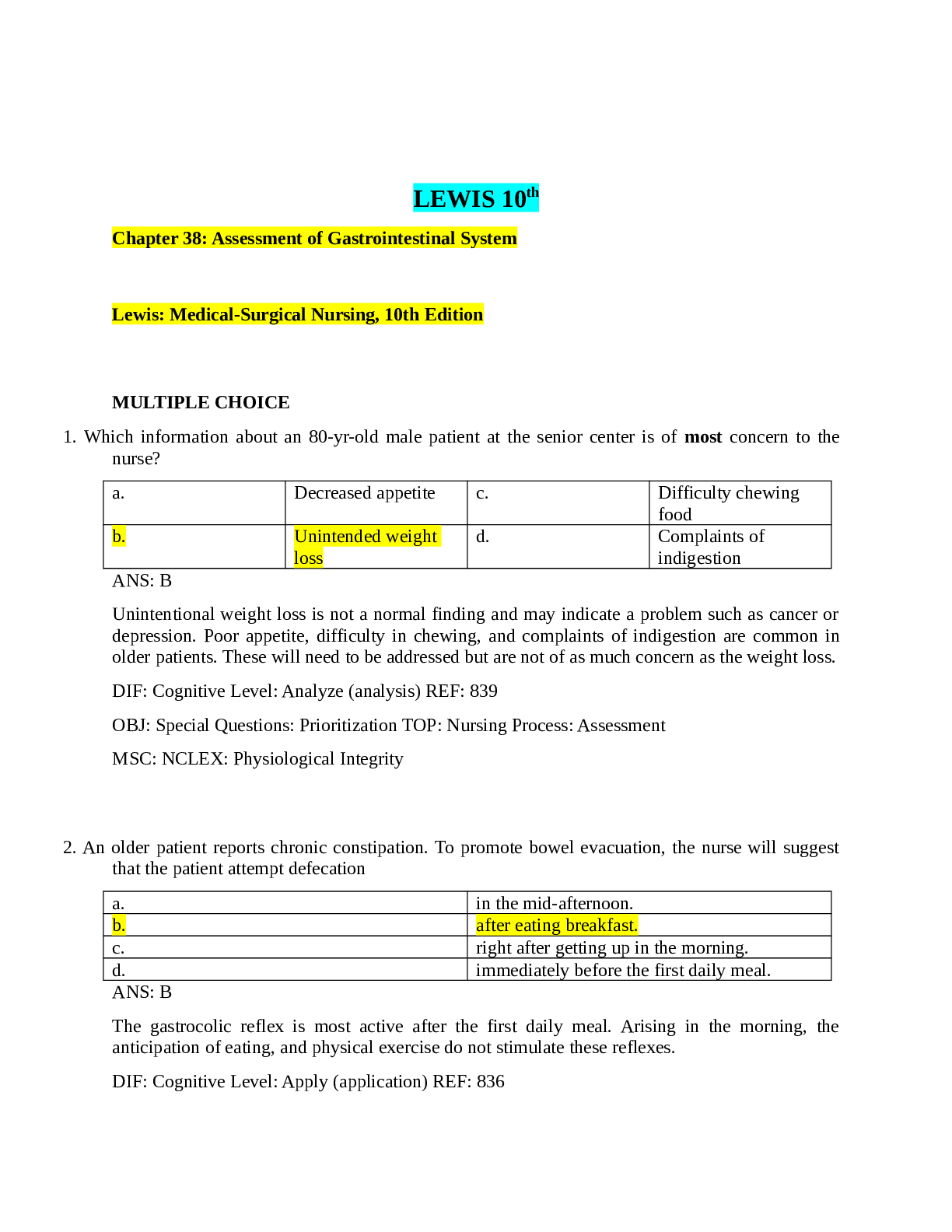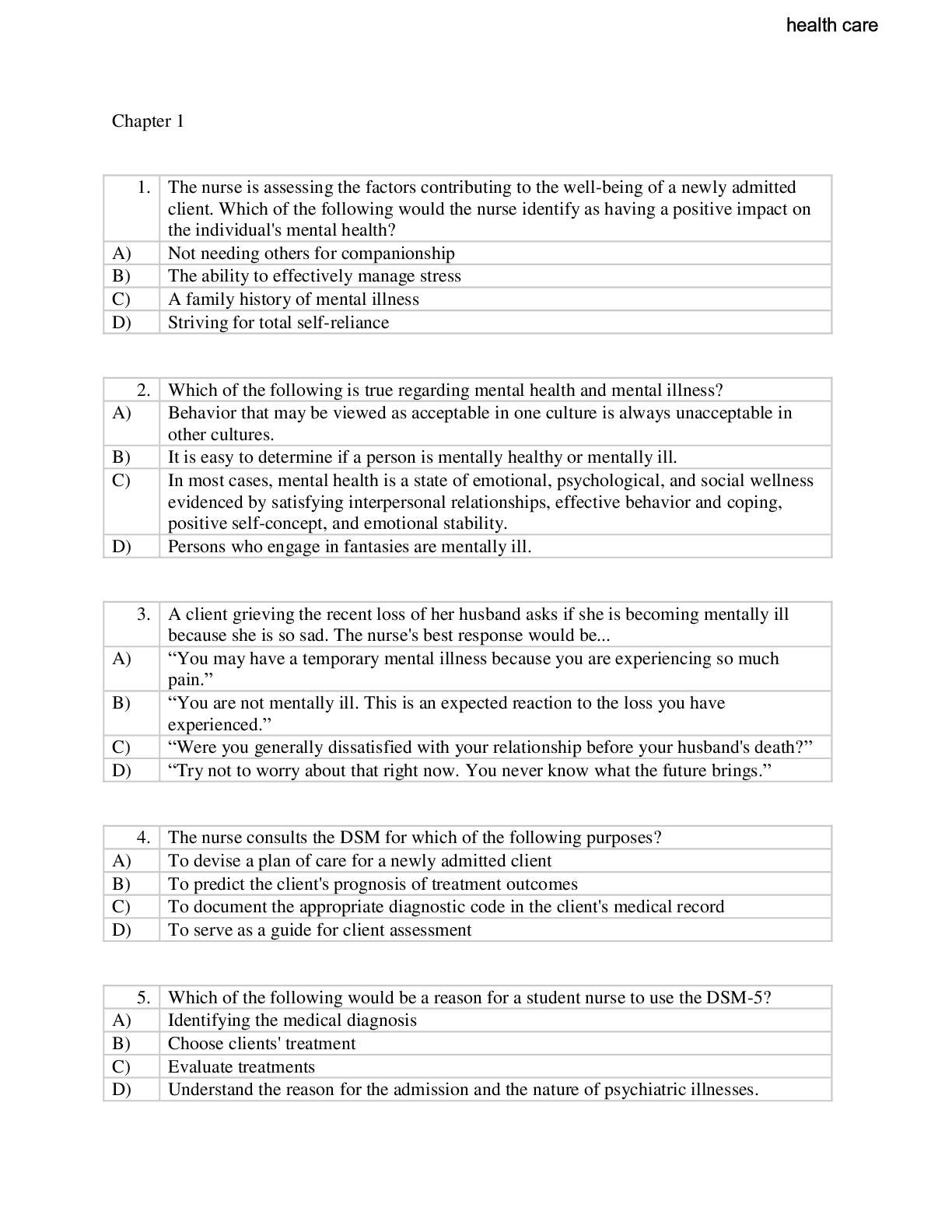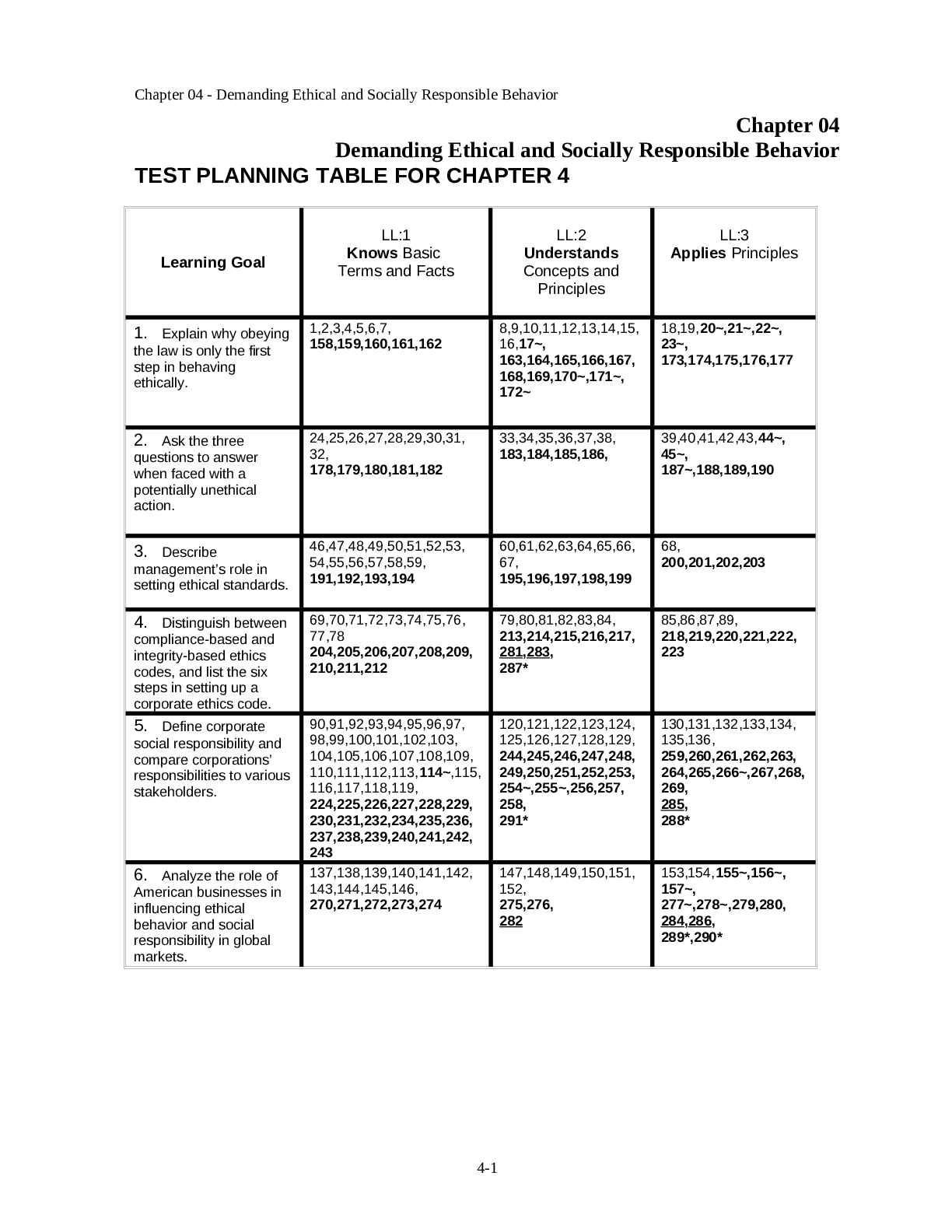Activity and Exercise _ Nursing Test Bank Rated 100%
Document Content and Description Below
MULTIPLE CHOICE 1. A nurse observes a patient rising from a chair slowly by pushing on the chair arms. Which type of tension and contraction did the nurse observe? a. Eccentric tension and isotonic... contraction b. Eccentric tension and isometric contraction c. Concentric tension and isotonic contraction d. Concentric tension and isometric contraction ANS: A This movement causes eccentric tension and isotonic contraction. Eccentric tension helps control the speed and direction of movement. For example, when using an overhead trapeze, the patient slowly lowers himself to the bed. The lowering is controlled when the antagonistic muscles lengthen. By pushing on the chair arms and rising eccentric tension and isotonic contraction occurred. In concentric tension, increased muscle contraction causes muscle shortening, resulting in movement such as when a patient uses an overhead trapeze to pull up in bed. Concentric and eccentric muscle actions are necessary for active movement and therefore are referred to as dynamic or isotonic contraction. Isometric contraction (static contraction) causes an increase in muscle tension or muscle work but no shortening or active movement of the muscle (e.g., instructing the patient to tighten and relax a muscle group, as in quadriceps set exercises or pelvic ߔoor exercises). 10/15/2016 Chapter 39: Activity and Exercise | Nursing Test Banks http://boostgrade.info/chapter39activityandexercise/ 2/24 DIF:Apply (application)REF:790 OBJ: Describe the role of the musculoskeletal and nervous systems in the regulation of activity and exercise. TOP: Assessment MSC: Health Promotion and Maintenance 2. A nurse notices that a patient has a structural curvature of the spine associated with vertebral rotation. Which condition will the nurse most likely ߔnd documented in the patient’s medical record? a. Scoliosis b. Arthritis c. Osteomalacia d. Osteogenesis ANS: A Scoliosis is a structural curvature of the spine associated with vertebral rotation. Osteogenesis imperfecta is an inherited disorder that makes bones porous, short, bowed, and deformed. Osteomalacia is an uncommon metabolic disease characterized by inadequate and delayed mineralization, resulting in compact and spongy bone. Arthritis is an inߔammatory joint disease characterized by inߔammation or destruction of the synovial membrane and articular cartilage and by systemic signs of inߔammation. DIF:Understand (comprehension)REF:791 OBJ: Describe the role of the musculoskeletal and nervous systems in the regulation of activity and exercise. TOP: Assessment MSC: Health Promotion and Maintenance 3. A nurse is caring for a patient who has some immobility from noninߔammatory joint degeneration. The nurse is teaching the patient about this process. Which information will the nurse include in the teaching session? a. This will aߔect synovial ߔuid. b. This will aߔect the body systemically. c. This involves mostly non–weight-bearing joints. 10/15/2016 Chapter 39: Activity and Exercise | Nursing Test Banks http://boostgrade.info/chapter39activityandexercise/ 3/24 d. This involves overgrowth of bone at the articular ends. ANS: D Joint degeneration, which can occur with inߔammatory and noninߔammatory disease, is marked by changes in articular cartilage combined with overgrowth of bone at the articular ends. Degenerative changes commonly aߔect weight-bearing joints. Synovial ߔuid is normal in noninߔammatory diseases. Inߔammatory joint disease (e.g., arthritis) is characterized by inߔammation or destruction of the synovial membrane and articular cartilage and by systemic signs of inߔammation. DIF:Apply (application)REF:791 OBJ: Discuss the inߔuence of immobility on body alignment, joint movement, and activity. TOP: Teaching/Learning MSC: Physiological Adaptation 4. The nurse is providing care to a patient who is bedridden. The nurse raises the height of the bed. What is the rationale for the nurse’s action? a. Narrows the nurse’s base of support. b. Allows the nurse to bring feet closer together. c. Prevents a shift in the nurse’s base of support. d. Shifts the nurse’s center of gravity farther away from the base of support. ANS: C Raising the height of the bed when performing a procedure prevents bending too far at the waist and shifting the base of support. Balance is maintained by proper body alignment and posture through two simple techniques. First, widen the base of support by separating the feet to a comfortable distance. Second, increase balance by bringing the center of gravity closer to the base of support. DIF:Apply (application)REF:788 OBJ escribe how to maintain and use proper body mechanics. 10/15/2016 Chapter 39: Activity and Exercise | Nursing Test Banks http://boostgrade.info/chapter39activityandexercise/ 4/24 TOP: Planning MSC: Safety and Infection Control 5. A nurse is following the no-lift policy when working to prevent personal injury. Which type of personal back injury is the nurse most likely trying to prevent? a. Thoracic b. Cervical c. Lumbar d. Sacral ANS: C The most common back injury for nurses is strain on the lumbar muscle group, which includes the muscles around the lumbar vertebrae. While cervical, thoracic, and sacral can occur, lumbar is the most common. DIF:Apply (application)REF:803 OBJ escribe how to maintain and use proper body mechanics. TOP lanningMSC:Health Promotion and Maintenance 6. The nurse is caring for a patient in the emergency department with an injured shoulder. Which type of joint will the nurse assess? a. Fibrous b. Synovial c. Synergistic d. Cartilaginous ANS: B 10/15/2016 Chapter 39: Activity and Exercise | Nursing Test Banks http://boostgrade.info/chapter39activityandexercise/ 5/24 Synovial joints, or true joints, such as the hinge type at the elbow, are freely movable and the most mobile, numerous, and anatomically complex body joints. Fibrous joints ߔt closely together and are ߔxed, permitting little, if any, movement such as the syndesmosis between the tibia and the ߔbula. Synergistic is a type of muscle, not joint. Cartilaginous joints have little movement but are elastic and use cartilage to unite separate bony surfaces such as the synchondrosis that attaches the ribs to the costal cartilage. DIF:Understand (comprehension)REF:789 OBJ: Describe the role of the musculoskeletal and nervous systems in the regulation of activity and exercise. TOP: Assessment MSC: Physiological Adaptation 7. The nurse is caring for a patient with inner ear problems. Which goal is the priority? a. Maintain balance. b. Maintain proprioception. c. Maintain muscle strength. d. Maintain body alignment. ANS: A Within the inner ear are the semicircular canals, three ߔuid-ߔlled structures that help maintain balance. Proprioception is the awareness of the position of the body and its parts, and proprioceptors are located on nerve endings, not the inner ear. Muscle strength is maintained with activity and exercise. Although body alignment is important, it is not maintained by the inner ear. DIF:Apply (application)REF:791 OBJ: Describe the role of the musculoskeletal and nervous systems in the regulation of activity and exercise. TOP: Planning MSC: Safety and Infection Control 8. A nurse is teaching a health promotion class about isotonic exercises. Which types of exercises will the nurse give as examples? a. Swimming, jogging, and bicycling b. Tightening or tensing of muscles without moving body parts 10/15/2016 Chapter 39: Activity and Exercise | Nursing Test Banks http://boostgrade.info/chapter39activityandexercise/ 6/24 c. Quadriceps set exercises and contraction of the gluteal muscles d. Push-ups, hip lifting, pushing feet against a footboard on the bed ANS: A Examples of isotonic exercises are walking, swimming, dance aerobics, jogging, bicycling, and moving arms and legs with light resistance. Isometric exercises involve tightening or tensing of muscles without moving body parts. Examples include quadriceps set exercises and contraction of the gluteal muscles. Examples of resistive isometric exercises are push-ups and hip lifting, as well as placing a footboard on the foot of the bed for patients to push against with their feet. DIF:Apply (application)REF:788 OBJ: Describe the evidence that supports regular activity and exercise in patient care. TOP: Teaching/Learning MSC: Health Promotion and Maintenance 9. An adolescent tells the nurse that a health professional said the ߔbrous tissue that connects bone and cartilage was strained in a sporting accident. On which structure will the nurse focus an assessment? a. Tendon b. Ligament c. Synergistic muscle d. Antagonistic muscle ANS: B Ligaments are white, shiny, and ߔexible bands of ߔbrous tissue that bind joints and connect bones and cartilage. Tendons are strong, ߔexible, and inelastic as they serve to connect muscle to bone. Muscles attach bone to bone. Synergistic muscles contract to accomplish the same movement. Antagonistic muscles cause movement at the joint [Show More]
Last updated: 1 year ago
Preview 1 out of 24 pages
Instant download
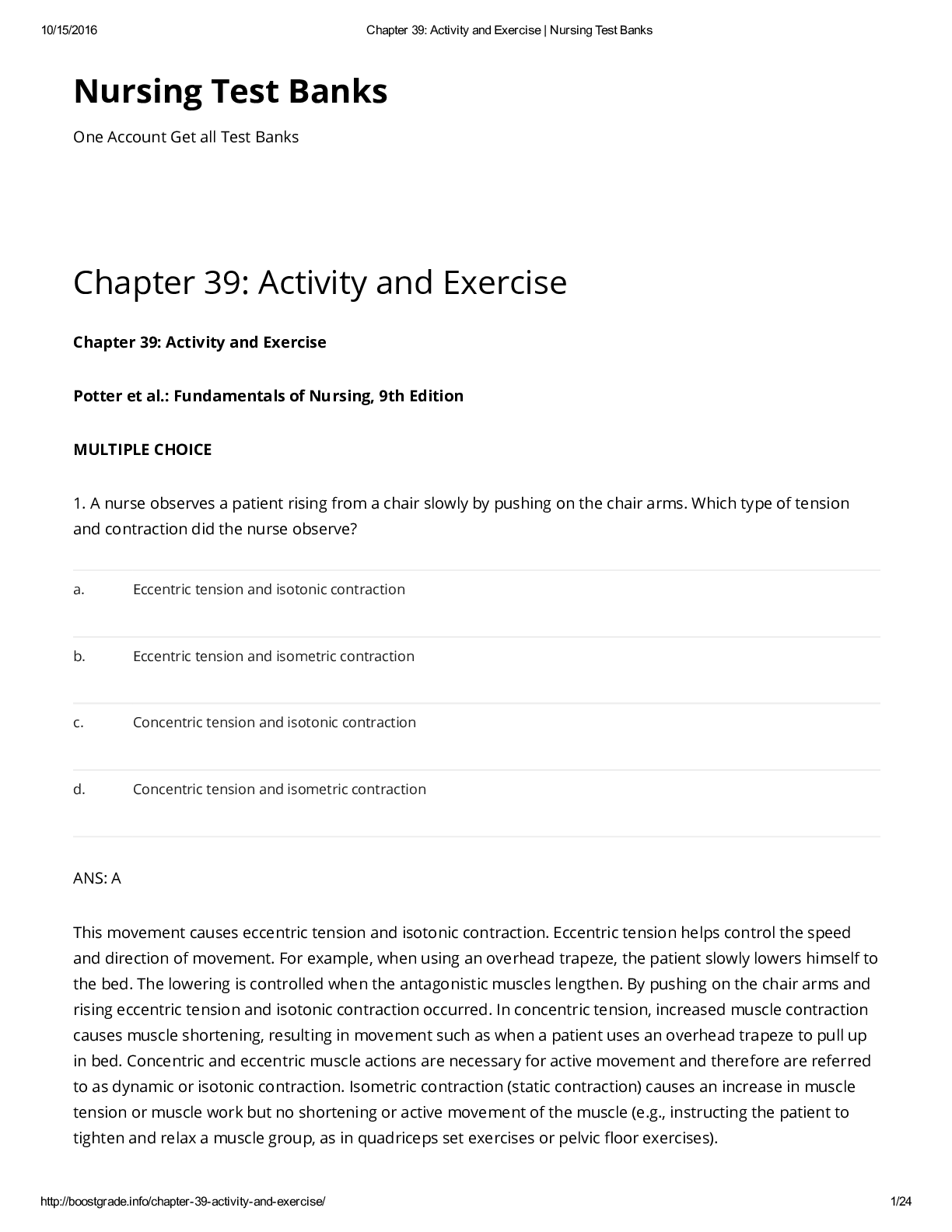
Buy this document to get the full access instantly
Instant Download Access after purchase
Add to cartInstant download
Reviews( 0 )
Document information
Connected school, study & course
About the document
Uploaded On
Aug 27, 2021
Number of pages
24
Written in
Additional information
This document has been written for:
Uploaded
Aug 27, 2021
Downloads
0
Views
70

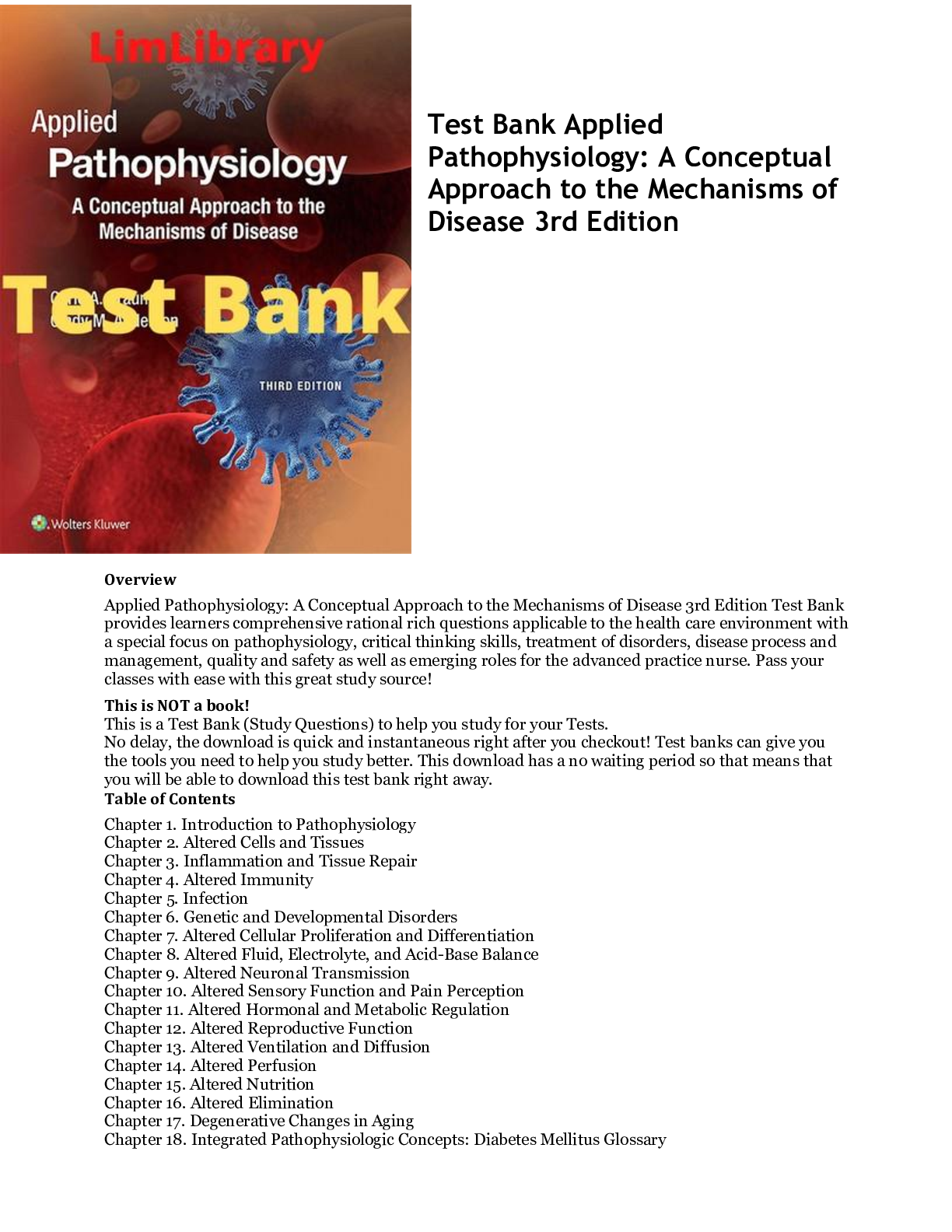

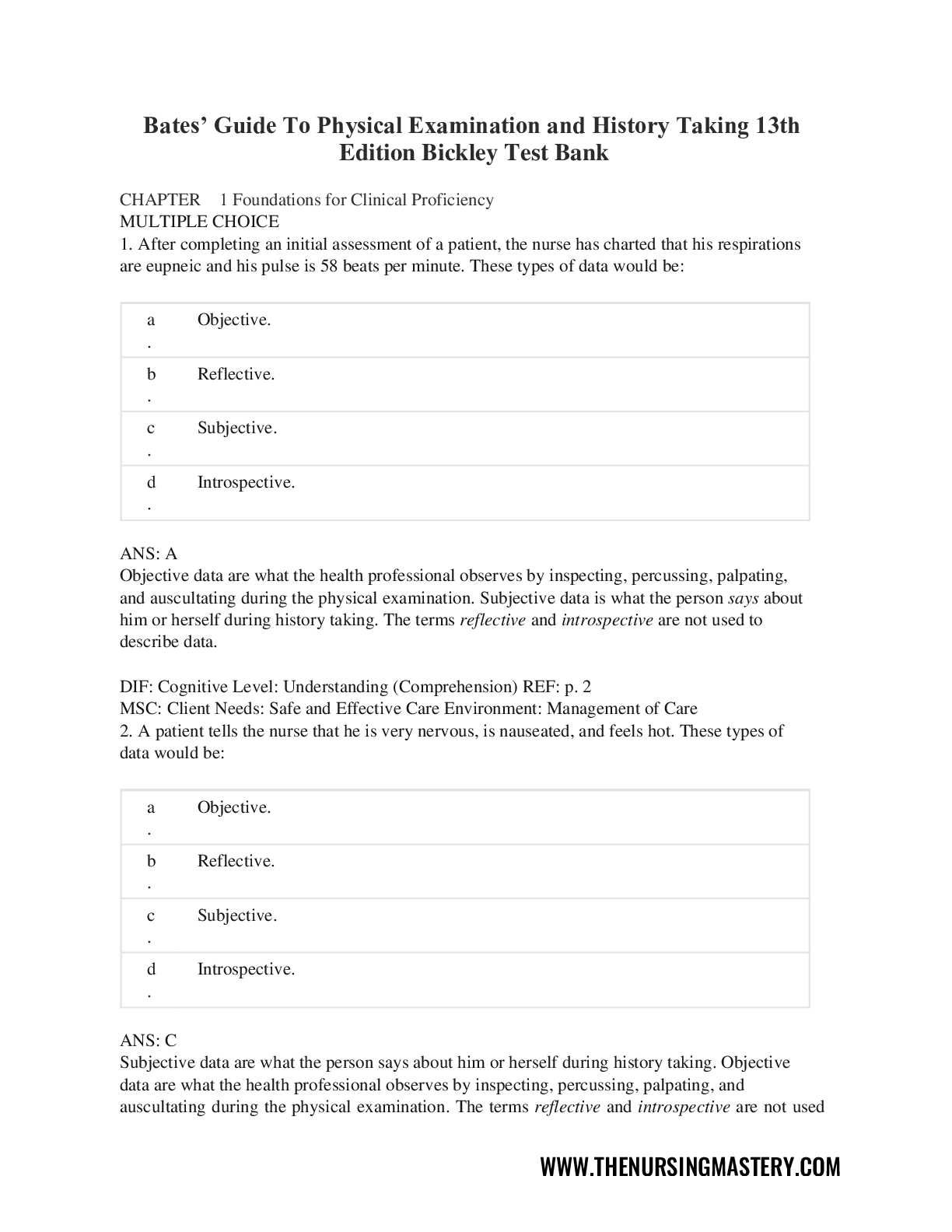
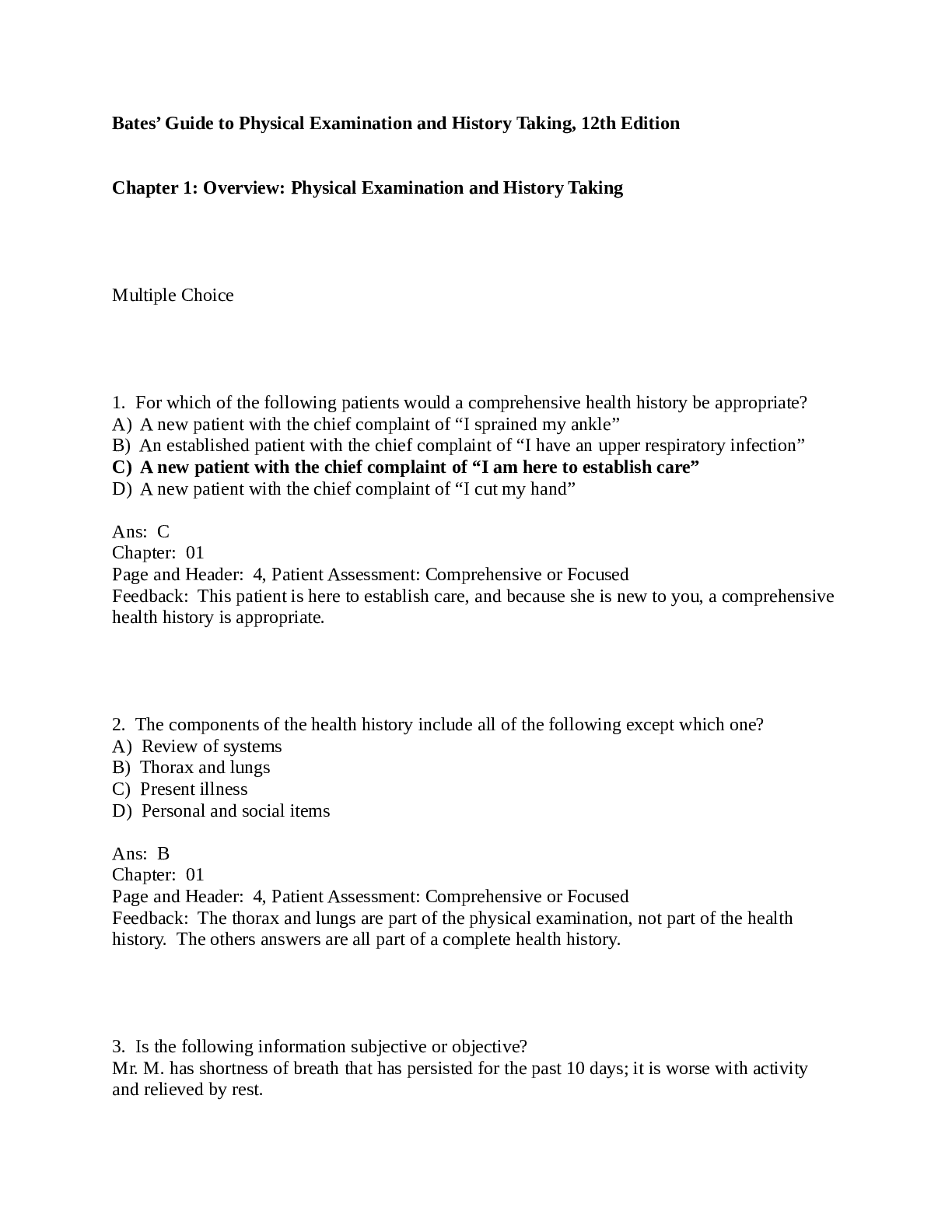
.png)
.png)
.png)

